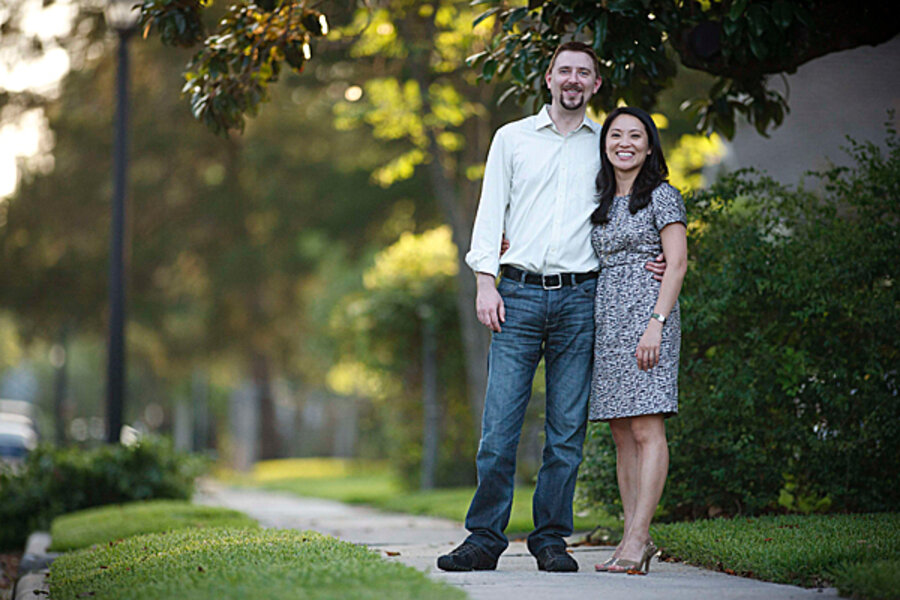Interracial marriage: more than double the rate in the 1980s
Loading...
Americans are more likely than ever before to marry outside their race or ethnicity.
Nearly 1 in 7 marriages in 2008 was interracial or interethnic, according to a report released by the Pew Research Center Friday. That’s more than double the intermarriage rate of the 1980s and six times the intermarriage rate of the 1960s.
Also, most Americans say they approve of interracial marriage, with more than 6 in 10 saying they’re OK if a family member marries outside his or her group. Thirty-five percent say they already have a family member who is married to someone of a different race or ethnicity.
“Race relations have certainly changed in a positive way,” says Daniel Lichter, a professor of sociology at Cornell University in Ithaca, N.Y. “This indicates greater racial tolerance, a blurring of the racial divides in the US. In general, it’s an optimistic report.”
Still, he cautions against notions that the United States is entering a postracial era.
“I don’t think these racial boundaries are going to go away anytime soon, despite these patterns we’re seeing over past 20 years,” Dr. Lichter says. “It’s hard to imagine the black-white divide in particular is going to go away anytime soon.”
Immigration, changing attitudes drive trend
Waves of immigrants from Latin America and Asia are driving the intermarriage trend by enlarging the pool of potential marriage partners, says Jeffrey Passel, a lead researcher and author of Pew’s report.
“American society is becoming more diverse, and workplaces, schools, and other arenas are fairly open so people can meet others of different races on one-to-one levels,” Mr. Passel says. “Underneath that, there’s a broad acceptance of interracial marriages that 40 or 50 years ago just didn’t exist.”
But, he adds, “It’s very much a generational phenomenon.” While 80 to 90 percent of people under age 30 say they find interracial marriages acceptable, that number falls to about 30 percent for those over 65, he says. “People 65 and over grew up in the ’30, ’40s, and ’50s when such things weren’t acceptable or were illegal. That’s an indicator of how things have changed.”
Whites', blacks' rate of intermarriage rising; Hispanics, Asians steady
Approximately 280,000 of the roughly 2 million marriages in 2008 were between spouses of different races or ethnicities, according to the Pew report. White-Hispanic couplings accounted for the greatest proportion of those intermarriages, at 41 percent. White-Asian couples made up 15 percent, and white-black couples 11 percent.
The report found vastly different rates of intermarriage for each of the groups studied. Among all newlyweds in 2008, 9 percent of whites, 16 percent of blacks, 26 percent of Hispanics, and 31 percent of Asians married someone whose race or ethnicity was different from their own.
But while blacks nearly tripled their intermarriage rates from 1980, and whites more than doubled theirs, the rates have hardly changed for Hispanics and Asians over the past 30 years.
“For whites and blacks, new [Asian and Hispanic] immigrants and their now grown US-born children have enlarged the pool of potential partners for marrying outside one’s own racial or ethnic group,” Passel writes in the Pew report. “But for Hispanics and Asians, the ongoing immigration wave has greatly enlarged the pool of potential partners for in-group marrying.”
Lichter of Cornell has documented this trend in his own research. In some cases, he says, immigration is reinforcing cultural and ancestral identities.
“Native-born populations are returning to their national-origin group, in part through marriage,” he says. “An increasing share of second-generation Hispanics are marrying first-generation immigrants. If marriage is one factor of assimilation, this represents a slowdown in assimilation among Asians and Hispanics.”
Black men and Asian women have highest rates of intermarriage
The report also tracks stark differences in intermarriage by gender.
Some 22 percent of black male newlyweds in 2008 married outside their race, compared with just 9 percent of black female newlyweds.
Among Asians, it's an opposite pattern. Some 40 percent of Asian female newlyweds in 2008 married outside their race, compared with just 20 percent of Asian male newlyweds.
“A lot of this has to do with cultural definitions of beauty and stereotypes of gender roles ... the exotic Asian woman and the patriarchal man,” Lichter says.
This can also create tension within racial and ethnic communities.
“The opportunities to marry for African-American women are exacerbated by high shares of black men marrying out, combined with extraordinarily high rates of incarceration among black men and higher rates of mortality," says Lichter. "That leads to a shortage of men to marry in the black community.”
Related:
La. interracial marriage: Is life tougher for biracial kids?
A year into Obama’s presidency, is America postracial?
Arizona immigration law: two rallies, two very different views





